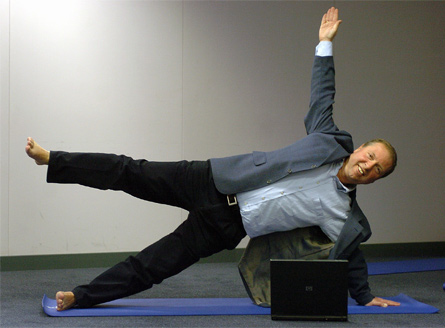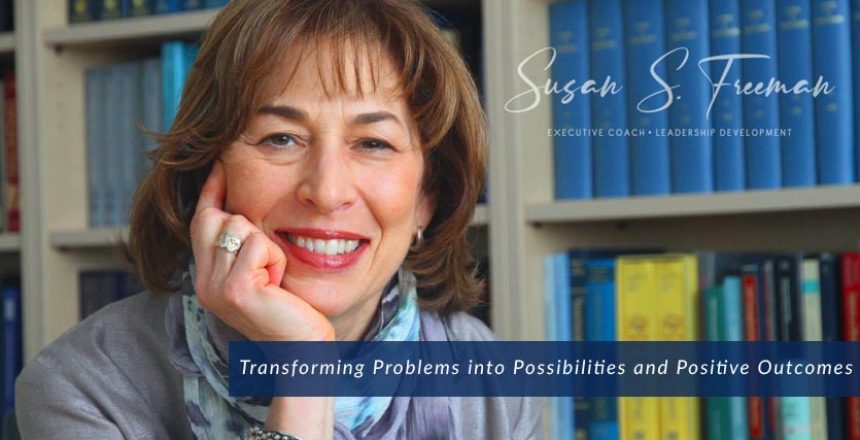 Many of you are familiar with yoga as a discipline. What you may be less familiar with is that yoga is a profound teaching tool for the art of leadership. As a coach who helps entrepreneurial leaders and their teams break through barriers for extraordinary professional and personal results, I want to share a leadership secret.
Many of you are familiar with yoga as a discipline. What you may be less familiar with is that yoga is a profound teaching tool for the art of leadership. As a coach who helps entrepreneurial leaders and their teams break through barriers for extraordinary professional and personal results, I want to share a leadership secret.
Leaders can only create externally that which they can create first internally.
In other words, if you work first on your “inner game,” the outer game of influencing others reflects it. To change the outer situation without awareness of your own internal state will at best produce frustration, and at worst damaged relationships.
I have found yoga and the practice of meditative awareness to be a foundational tool for helping leaders achieve this internal awareness. My clients demonstrate, week after week, that as they learn to dial down their repetitive, habitual thoughts, new possible actions become available. Usually they are previously unimaginable possibilities.
How and why do yogic traditions work so effectively for leaders?
There are two fundamental yogic principles that translate to transformation off the mat.
The first yogic principle is learning to breathe effectively.
Your state of mind is directly related to the state of your breath. So, in order to change your state of mind, simply change your breath! When clients first begin to practice this, they soon discover its power for themselves. It really is that simple. We complicate what is simple because of our heavy dependence on the ego-mind. We believe we are our thoughts. That is scary because the mind swims in thoughts, generating almost 2000 of them in an hour!
First, I ask my leaders learn to access meditative awareness through a basic belly breath. This helps reduce the high-alert status of the sympathetic nervous system that is most often engaged at work. Simply learning how to shift your breathing pattern will change your ability to see people and opportunities with a different perspective. This is due to the fact that when you slow down enough to access the para-sympathetic nervous system, you can access brain waves that correlate with heightened creativity, visualizations and integrated thinking. These are referred to as the “higher intelligences.”
 The second yogic principle is that of “going to your edge.”
The second yogic principle is that of “going to your edge.”
Yoga affords the opportunity to use the physical body as a vehicle for psychological insight. People often think yoga is about putting your body into pretzel poses. Although that is the visible side of yoga, here is much more to yoga than that. Yoga means “union;” the integration of mind, body and soul. With yoga, you use the postures to get into your body; not the body to get into the postures!
This is an important distinction. Getting into the body means getting out of the mind. The mind is busy with its non-stop chatter of to-do lists, worries about the future, and ruminations from the past. In a yoga posture you are given the opportunity to experience pure sensation in the body. All the while, the mind chatter gradually starts to fall away.
What happens when you cannot easily enter a pose?
We call that “going to your edge.” When you first experience the edge, there will be the place where discomfort occurs. You notice a buildup of strong sensation. The body may feel pain. This is where the edge comes in. When you first go to your edge, what is your typical pattern?
Do you push through it? Do you force it? Do you back away and then beat yourself up? Are you comparing your posture to others nearby?
As sensation builds, you have an opportunity to do something different than what you may have done “off the mat.” You can simply breathe deeply and slowly through the belly, noticing what the changed breath pattern does to your thoughts. Observe that as your breathing pattern shifts, your body begins to relax into the pose. With deeper, slower breaths over a period of time, you may notice that you are effortlessly entering a pose that would have been impossible without the breath, and the awareness that breath created for you.
Going right up to your edge is where the transformation happens. The edge is the psychological border that brings up our typical patterns of engagement. These patterns are usually transparent to us in daily life. A yogic practice can be a portal to those patterns. We can explore what happens in our physical edges on the mat, so that when we are off the mat we can adopt the new learning in our daily lives.
Consider what may be limiting you at work. You have a familiar pattern of engagement, as do others. If you disrupt that patterning through awareness of your “edge,” what changes unfold?
Leadership is an art of engagement; the ability to influence others towards a shared vision. The edge offers a place of possibility for you to practice self-mastery, the place where leadership begins.
I have found these yogic principles to be effective in working with a wide range of leadership challenges. Although unique, they offer a powerful means for leaders who seek accelerated development and lasting change.

